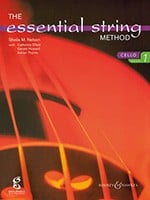
The Essential String Method
In focus
The Essential String Method has been developed and created by some of the UK’s leading string teachers under the general editorship of Sheila Nelson, in conjunction with the Guildhall School of Music and Drama and published by Boosey & Hawkes. The project represents a unique collaboration between practitioners, an innovative conservatoire and an international publisher.
Background - a new Guildhall School string curriculum
The Essential String Method grew out of a research project undertaken by the Guildhall School, who were rethinking the nature and structure of their graded examinations. Director of Initial Studies at the Guildhall, Eric Hollis, explains "We wanted to move away from the traditional syllabus-based exam structure to a more curriculum-based structure. We created the concept of a stringed instrument curriculum that would provide a framework drawing on recognised concepts in good teaching practice".
Working in collaboration with some of the UK’s most experienced string teachers, the Guildhall School created a radical and forward-thinking curriculum. The team consisted of three leading string teachers: Sheila Nelson, internationally renowned for her pioneering group violin teaching projects, Cathy Elliott (double bass) and Gerald Howard (cello) with Adrian Thorne devising the musicianship strategy to complement the instrumental skills. Focusing on the all-round musical development of the pupil, the curriculum integrates musical awareness, creativity and technical development from the outset.
The Essential String Method - publications
The Essential String Method, published by Boosey & Hawkes, makes this curriculum available in a series of clearly structured progressive books for violin, viola, cello and double bass. Making their way through the series, pupils encounter a wealth of new tunes and arrangements on which to build their repertoire. The material is presented as a logical progression of musical activities and games involving both the instrument and the voice. These make learning fun and are easily incorporated into instrumental lessons, simultaneously developing the pupil’s technical and musical abilities while reinforcing aspects of the school curriculum. The books contain everything for the basics of string and music teaching for the first few years of learning. The pieces can be used for The Guildhall School’s examinations but the method is equally an independent resource which can be integrated into all systems of music learning.
A creative approach to teaching and learning
The Essential String Method aims to offer a more active and creative approach to teaching and learning, as teacher Cathy Elliott explains: "It makes explicit the learning processes outlined throughout Sheila Nelson’s teaching materials. We are trying to equip children with general musicianship skills that will last them a lifetime ….. after a few years of study children will have developed a solid grounding in music and a range of skills transferable to every musical discipline".
Anthony Marks, Managing Editor responsible for overseeing the project comments "The Essential String Method is a complete resource for teacher and pupil alike. The material is ingeniously presented; it is lively and attractive to children, and at the same time clear and informative for teachers. The design enables young players to focus instantly on the elements of the book that they need - music, games and pictures - but all the additional information is there too, clearly expressed in language that people of all ages will understand. The books are both instantly approachable and packed with detail, so that teacher and pupil can explore the scheme together. In all, the entire method is an unrivalled source of ideas for creative teaching and learning".
Teacher training and workshops
An integral part of disseminating the method is to provide teacher training and workshops, as Eric Hollis explains: "Central to the philosophy behind this project is the aim to provide a teaching structure …. the framework will be invaluable to schools, local authorities and private teachers, but above all it will form a strong and well tried foundation for instrumental teacher training and INSET".
